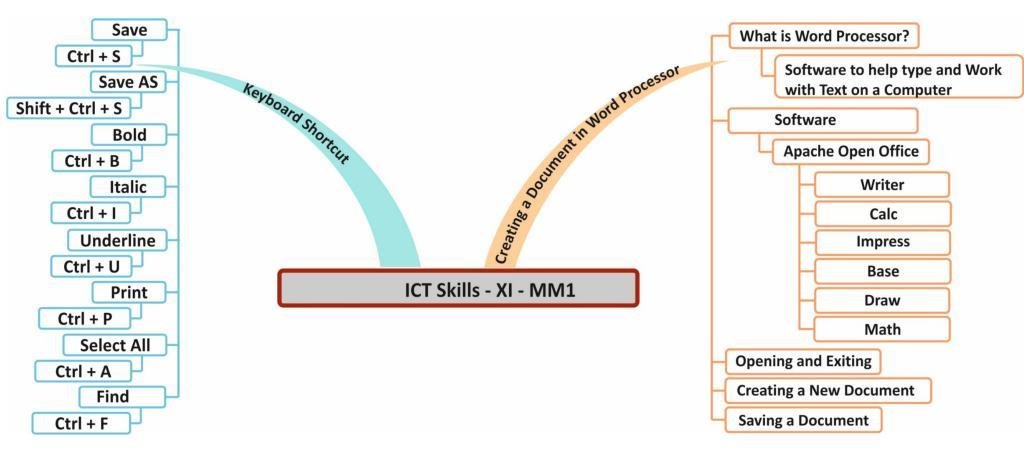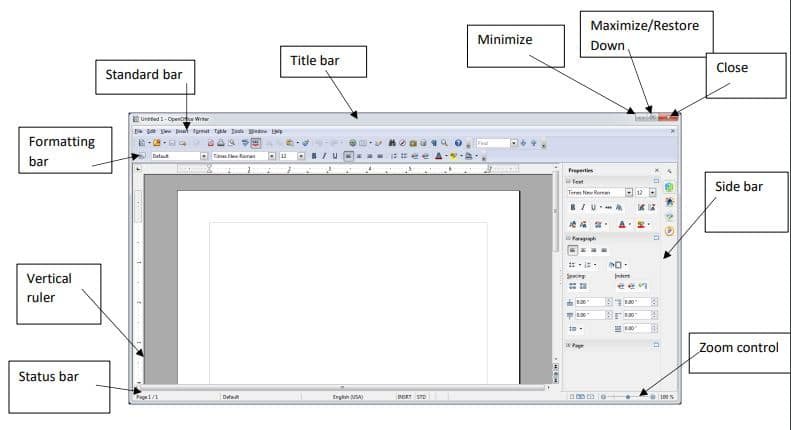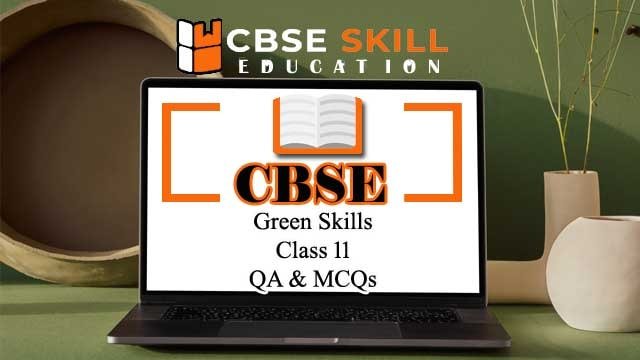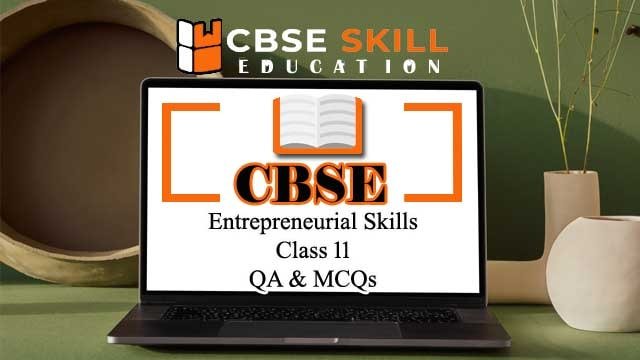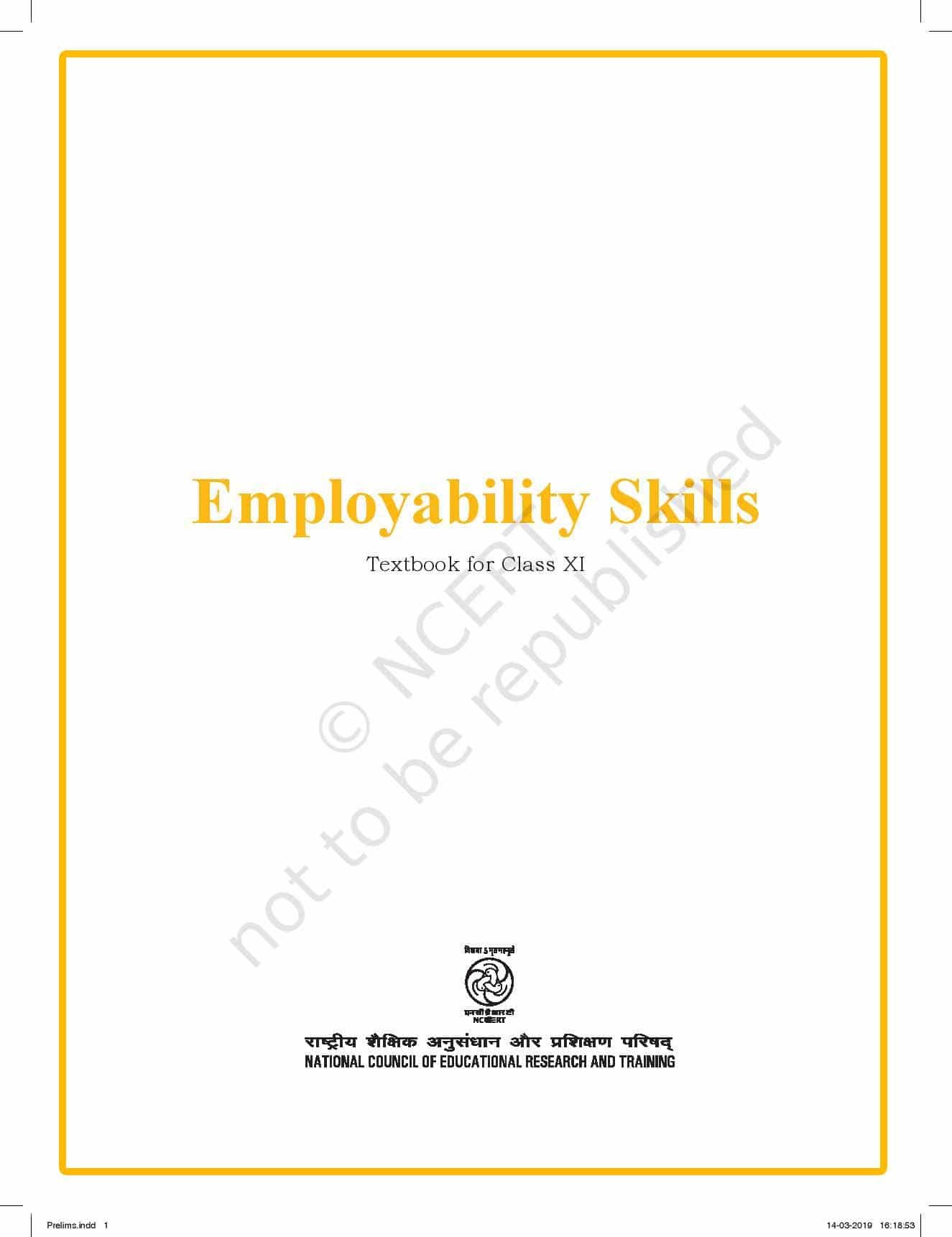Teachers and Examiners collaborated to create the Entrepreneurial Skills Class 11. The team has gathered all of the important MCQs and QA from Employability Skills Textbook. All of the MCQs & QA have been organized topic wise.
Entrepreneurial Skills Class 11
Session 1: Introduction to Entrepreneurship
1. The process of running a business with a new idea or in a different approach that benefits the buyer or consumer is known as ____________.
a. Entrepreneurship
b. Businessman
c. Planner
d. None of the above
Show Answer ⟶Hide Answer ⟵a. Entrepreneurship
2. An ____________ is a person who tries to meet the needs of a customer through new ideas or ways of doing business and makes profit in return.
a. Entrepreneurship
b. Businessman
c. Planner
d. None of the above
Show Answer ⟶Hide Answer ⟵a. Entrepreneurship
3. New ideas with which an entrepreneur adds value to a business can be of many kinds, including new products like _____________.
a. New marketing ideas
b. New Services like home delivery
c. Cost reduction ideas
d. All of the above
Show Answer ⟶Hide Answer ⟵d. All of the above
4. What are the various kinds of business activities?
a. Manufacturing Business
b. Services Business
c. Trading Business
d. All of the above
Show Answer ⟶Hide Answer ⟵d. All of the above
5. A ____________ is a business that turns raw materials into finished products to fulfill customer needs.
a. Manufacturing Business
b. Services Business
c. Trading Business
d. All of the above
Show Answer ⟶Hide Answer ⟵a. Manufacturing Business
6. A ____________ does not manufacture a good or product but only facilitates the act of bringing the finished goods from the manufacturing unit to the buyer or customer.
a. Manufacturing Business
b. Services Business
c. Trading Business
d. All of the above
Show Answer ⟶Hide Answer ⟵c. Trading Business
7. A business is any intangible economic activity that cannot be seen or felt but is for the benefit of a buyer.
a. Manufacturing Business
b. Services Business
c. Trading Business
d. All of the above
Show Answer ⟶Hide Answer ⟵b. Services Business
8. Who is an entrepreneur?
Answer – An entrepreneur tries to fulfill the customer’s needs through innovative ideas or methods of doing business, and in return, he or she generates a profit.
9. What are the three types of business activities?
Answer – Types of business Activities are –
a. Manufacturing Business – A manufacturing business is one that changes raw materials into finished products to satisfy client expectations.
b. Trading Business – A trading business does not make items or products, but they are transporting finished products from the production unit to the buyer or client.
c. Services Business – That type of services which give benefit to the buyer is called Services Business. Services do not have a set time and are flexible to meet the needs of the clients. Example – painting contractor, Computer services etc.
Entrepreneurial Skills Class 11
Session 2: Values of an Entrepreneur
10. Each entrepreneur has certain ___________ that make them successful.
a. Unique qualities
b. Values
c. Both a) and b)
d. None of the above
Show Answer ⟶Hide Answer ⟵c. Both a) and b)
11. Entrepreneur’s face a lot of difficulties, doubts and challenges when he/she is involved in Business. Identify the doubts ___________ of entrepreneurship.
a. Am I good enough to start a business
b. Can I run the Business on my own
c. What if my customers are dissatisfied with my product
d. All of the above
Show Answer ⟶Hide Answer ⟵d. All of the above
12. Being ____________ helps an entrepreneur to take the first step of starting a new business and then trying new things to grow the business.
a. Confident
b. Values
c. Qualities
d. None of the above
Show Answer ⟶Hide Answer ⟵a. Confident
13. An entrepreneur is her or his own boss and has to be ____________ to set goals and follow them.
a. Self – Respect
b. Self – Motivated
c. Self – Courage
d. None of the above
Show Answer ⟶Hide Answer ⟵b. Self – Motivated
14. ______________ means not to give up and keep going even when a difficult situation comes up.
a. Perseverance
b. Motivated
c. Respect
d. None of the above
Show Answer ⟶Hide Answer ⟵a. Perseverance
15. _____________ means to be open to trying new things and being open to others feedback.
a. Open – mindedness
b. Other – mindedness
c. Both a) and b)
d. None of the above
Show Answer ⟶Hide Answer ⟵a. Open – mindedness
16. What are the different doubts and fears that come in an entrepreneur mind?
Answer – Every entrepreneur has unique qualities that make him successful in Business. But before starting a business there are various thoughts, doubts and fears that come to entrepreneurs’ minds.
Some of the doubts and fears come in entrepreneur minds are –
a. Am I good enough to start a business
b. What if my customers don’t like my product
c. What if I make a loss or no one buys from me
d. What if my customers go to my competitors
e. Can I run the business on my own
17. What are the values which make an entrepreneur successful?
Answer – The values which make an entrepreneur successful are –
a. Confidence – Confidence means believing in yourself. Confidence helps entrepreneurs to start the business and helps to implement new things to develop business. It motivates the entrepreneur to keep going even if there are failures.
b. Independence – Independent entrepreneurs ability to work alone and take the decision independently.
c. Perseverance – Perseverance means without fear or continually working for the business even when a difficult situation comes up. Always remember that running a business involves many failures. Entrepreneurs have to overcome these failures.
d. Open – Mindedness – Open – Mindedness person always trying new ideas in the business and being open to others feedback. To start or grow the business an entrepreneur implements many different ideas.
Entrepreneurial Skills Class 11
Session 3: Attitude of an Entrepreneur
18. Entrepreneurs determine what type of job to do and how to execute it. They themselves make ____________ and work towards completing the work.
a. Decision
b. Responsible
c. Both a) and b)
d. None of the above
Show Answer ⟶Hide Answer ⟵c. Both a) and b)
19. What does the attitude mean in the topic entrepreneur?
Answer – The attitude of an entrepreneur reacts to different ideas and different situations. The attitude of an entrepreneur influences their decisions when running a business.
20. Write the key differences in attitudes between entrepreneurs and employees.
Answer – The key differences in attitudes between entrepreneurs and employees are –
Entrepreneur
a. Definition: The self employed person is an entrepreneur.
b. Pursues: An entrepreneur pursues his/ her goal of freedom.
c. Risk factor: An entrepreneur faces a high level of risk.
d. Work terms: An entrepreneur establishes his or her own terms and conditions.
e. Degree of freedom: The entrepreneur is completely self-sufficient.
f. Reward: Profits are given to entrepreneurs.
g. The role they play: Entrepreneurs are problem solvers.
h. Entrepreneurs are forward-thinking individuals.
Employee
a. Definition: An employee works for someone else.
b. Risk factor: An employee is not taking any risk.
c. Working circumstances: An employee is bound by the terms and conditions established by his employer.
d. Degree of liberty: Employees do not have any freedom.
e. Reward: An employee’s salary is their reward.
f. Their function: Employees are creative problem solvers.
g. Historical perspective: Employees take a look back in time.
Entrepreneurial Skills Class 11
Session 4: Thinking like an Entrepreneur
21. ________________ is the process of thinking, through which entrepreneurs can come up with many solutions to improve their business.
a. Problem Solving
b. Decision Making
c. Responsibility
d. None of the above
Show Answer ⟶Hide Answer ⟵a. Problem Solving
22. What problems entrepreneurs face when they want to run the business.
a. Money problem
b. Acquiring material
c. Pricing
d. All of the above
Show Answer ⟶Hide Answer ⟵d. All of the above
23. _____________ means to understand a situation or problem by asking oneself questions and researching about reasons for the situation or a problem.
a. Critical thinking
b. Innovation
c. Creativity
d. None of the above
Show Answer ⟶Hide Answer ⟵a. Critical thinking
24. What are the key problems an entrepreneur may face while running a business?
Answer – Problem-solving is a thought process that allows entrepreneurs to come up with several ways to improve their business.
The problems an entrepreneur may face are –
a. Idea
b. Money
c. Acquiring material
d. Manufacturing
e. Pricing
f. Marketing and advertising
g. Selling
h. Accounting
i. Growing business
25. What are different ways in which an entrepreneur can think to solve problems?
Answer – In their daily operations, entrepreneurs handle a wide range of problems.
a. Creativity – An entrepreneur must believe in their ability to come up with new ideas to solve a problem.
b. Innovation – Innovation means thinking up new ideas and coming up with ways to make them work in real life. The difference between creativity and innovation is that, whereas creativity is simply coming up with an idea, innovation means coming up with an idea and making that idea a reality.
c. Critical Thinking – An entrepreneur always thinks differently when he/she is faced with a problem. Entrepreneurs never worry about the problem he/she always try to find out the solution.
Entrepreneurial Skills Class 11
Session 5: Coming up with a Business Idea
26. What are the basic principles to start a business?
a. Customer Need
b. Entrepreneurs Own Interest or Talent
c. Innovative
d. All of the above
Show Answer ⟶Hide Answer ⟵d. All of the above
27. Identify the different ways to come up with ideas.
a. Location – based Ideas
b. Seasonal Ideas & Events – based ideas
c. Interest – driven Ideas – Vocation – driven Ideas
d. All of the above
Show Answer ⟶Hide Answer ⟵d. All of the above
27. What is a Business Idea and what are the different principles of idea creation?
Answer – A business idea is a solution provided by an entrepreneur to serve the client.
There are a few important principles to keep in mind while coming up with and idea.
a. Customer Need – A business idea can arise from an existing market demand or from a desire to improve what is already offered in the market.
b. Entrepreneur’s Own Interest or Talent – Some entrepreneurs start the business using their own talent or interest. Talent and Interest is very important for an entrepreneur to create self-confidence and if self – confidence is created then others believe in your capabilities and it helps the business to grow.
c. Innovative – The business will grow if you have innovative ideas and it also depends on how you have implemented the idea in your business.
28. What are different ways of coming up with an idea? State different ways with an example.
Answer – The majority of ideas come from either consumer needs or inspiration from what others are doing. There are numerous methods for coming up innovative ideas
a. Location based Ideas – Some of the entrepreneurs implement the idea to serve the needs of the local customers. For example, In Rajasthan, where water supply is limited, an entrepreneur can start a business to sell the water in Rajasthan .
b. Seasonal Ideas – In the summer season, people want to drink Cold Juice or any healthy drinks in big cities while in winters people like to drink warm beverages.
c. Events – based Ideas – Another technique to generate a business concept is to consider how to serve people during events. For example During the wedding season, several businesses grow, such as card designers and printers, mehendi designers, event organizers, decorators, and so on.
d. Interest – driven Ideas – Entrepreneurs can generate business concepts based on their own self-interest. For example, Someone who is talented at dance and enjoys dancing, could create a dance training institute.
e. Vocation – driven Ideas – Many of the businesses started based on the interest and what they are knowing. For example, A farmer who knows everything about farming can start a Framer Training Institute and help other farmers.
Entrepreneurial Skills Class 11
Session 6: Understanding the Market
29. Customer Needs can be categorized into _________.
a. Quality and Quantity
b. Pricing
c. Location
d. All of the above
Show Answer ⟶Hide Answer ⟵d. All of the above
30. An entrepreneur has to do ______________ to understand whether there is a market for what they have to offer.
a. Customer survey
b. Customer location
c. Customer needs
d. None of the above
Show Answer ⟶Hide Answer ⟵a. Customer survey
31. What are the key aspects of competition in business?
a. Pricing
b. Offers
c. Customer Relations
d. All of the above
Show Answer ⟶Hide Answer ⟵d. All of the above
32. What are the two ways of understanding the market?
Answer – The two ways to understanding the market are –
a. Customer Needs and preferences – Customer needs is categorized into four types.
b. Served Needs – These are needs that customers know and are fulfilled by different businesses or the government.
c. Partially served Needs – When needs are served from different services and products, but the customer is not satisfied and still facing the problem.
d. Unserved and known Needs – Customers are aware of these needs, but no one in the market is fulfilling them.
Unknown Needs – These are needs that people have, but are not aware or do not expect for it to get solved by a business.
e. Competitive Businesses – Competitive Businesses is categorized into five types
f. Quality and Quantity – An entrepreneur must understand the customer’s expectation in terms of the quality.
g. Pricing – An entrepreneur must understand the selling price and he/she should understand what price the customer will be willing to buy a product.
h. Location – Location means the place from where customers are going to buy the product.
i. Time – An entrepreneur should understand in which season or which month would a customer buy the product.
j. Frequency – Frequency means how many times a customer buys the product or services.
33. What are the different aspects of understanding competition?
Answer – The key aspects of understanding competition are –
a. Positioning – It is important to try to understand how competitors position their businesses.
b. Pricing – Understanding the price at which different competitors sell their product or service.
c. Customer Relations – Another important aspect is how a business can make the relation with customers.
34. How can an entrepreneur find out about competition?
Answer – To learn about the competition, an entrepreneur should go directly to the customer and ask questions about pricing, offers, qualities, whether you like the product or not.
Entrepreneurial Skills Class 11
Session 7: Business Planning
35. A business plan is important for an entrepreneur. Identify the reasons why a business plan should be prepared.
a. Estimating the money required to be spent
b. Estimating quality of material required
c. Standing out & Setting goals
d. All of the above
Show Answer ⟶Hide Answer ⟵d. All of the above
36. A ______________ is a detailed plan of what an entrepreneur wants to achieve through the business and how it will be achieved.
a. Business plan
b. Customer needs
c. Business needs
d. None of the above
Show Answer ⟶Hide Answer ⟵a. Business plan
37. While planning for a business, an entrepreneur has to think about different factors, Identify the factors.
a. Customer Group & Product/Service
b. Material Required and cost
c. Selling method and Location
d. All of the above
Show Answer ⟶Hide Answer ⟵d. All of the above
38. What are the principles which can be followed to grow a business?
a. Quality
b. Adding Substitutes
c. Scaling Up
d. All of the above
Show Answer ⟶Hide Answer ⟵d. All of the above
39. What is the meaning of business planning?
Answer – An entrepreneur must have a business plan. When an entrepreneur has determined what to sell, and if the customers are willing to buy the product or services, then entrepreneur should planned for –
a. Estimating the money required to be spent – Once the entrepreneurs understand the product and the customer, the next step is to estimate how much money will be required to start the business.
b. Estimating quantity of material required – After knowing the cost price of the manufactured product, the entrepreneur first identifies the market price and then he/she has to decide the cost of selling each product.
c. Standing out – A business plan is important, an entrepreneur plan how they can make the customer see the business as standing out uniquely when compared with competitors.
d. Setting goals – Another important reason for having a plan is to set ambitious, yet realistic goals. These goals motivate the entrepreneur to work hard.
40. How can an entrepreneur improve and grow a business? State the principles.
Answer – principles which can be followed to grow a business are –
a. Quality – An entrepreneur might grow his or her business by improving the quality of the product or service given to customers.
b. Scaling Up – Growing the business by recruiting new clients is what scaling up includes. There are numerous ways for a business to reach out to an increasing number of clients.
c. Adding Substitutes – Giving consumers special deals is another strategy to grow a business. Substitutes are products and services that are identical to what is currently on the market.
Employability Skills Class 11 Notes
Unit 1 : Communication Skills – III
Unit 2 : Self-Management Skills – III
Unit 3 : Information and Communication Technology Skills – III
Unit 4 : Entrepreneurial Skills – III
Unit 5 : Green Skills – III
Employability Skills Class 11 MCQ
Unit 1 : Communication Skills – III
Unit 2 : Self-Management Skills – III
Unit 3 : Information and Communication Technology Skills – III
Unit 4 : Entrepreneurial Skills – III
Unit 5 : Green Skills – III
Employability Skills Class 11 Questions and Answers
Unit 1 : Communication Skills – III
Unit 2 : Self-Management Skills – III
Unit 3 : Information and Communication Technology Skills – III
Unit 4 : Entrepreneurial Skills – III
Unit 5 : Green Skills – III
Reference Textbook
The above Entrepreneurial Skills Class 11 was created using the NCERT Book and Study Material accessible on the CBSE ACADEMIC as a reference.
CBSE study material of employbality class XI. (n.d.). Retrieved April 5, 2022, from https://cbseacademic.nic.in/web_material/Curriculum20/publication/srsec/employability-XI.pdf
Your valuable Feedback
Greetings Readers, Thank you for taking the time to reading Entrepreneurial Skills Class 11. Please take a few moments to write down any recommendations you may have for our website. Please leave your thoughts in the comment box below.
Disclaimer – 100% of the questions are taken from the CBSE textbook Entrepreneurial Skills Class 11, and our team has tried to collect all the correct MCQs and QA from the textbook . If you found any suggestion or any error please contact us anuraganand2017@gmail.com.

